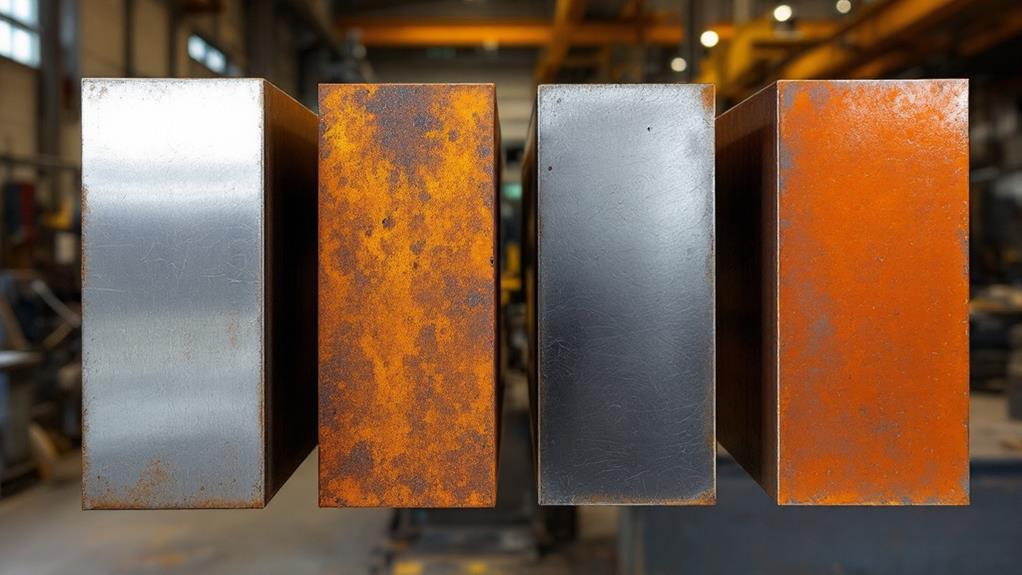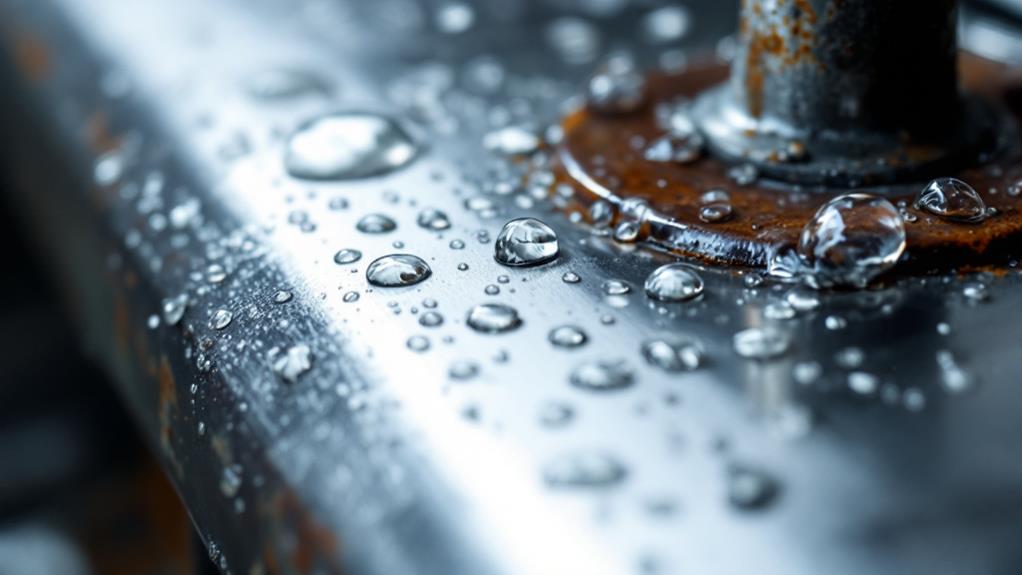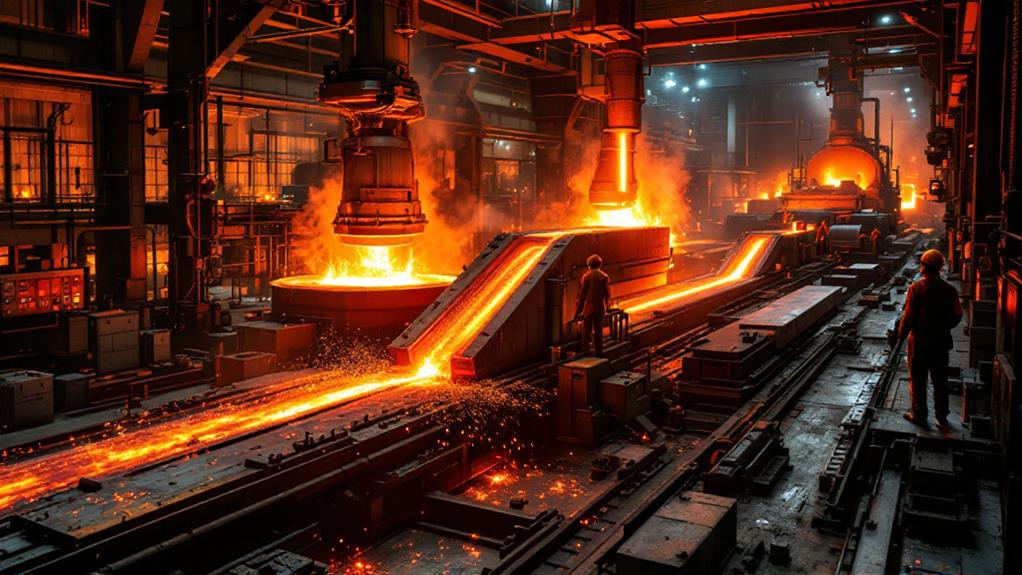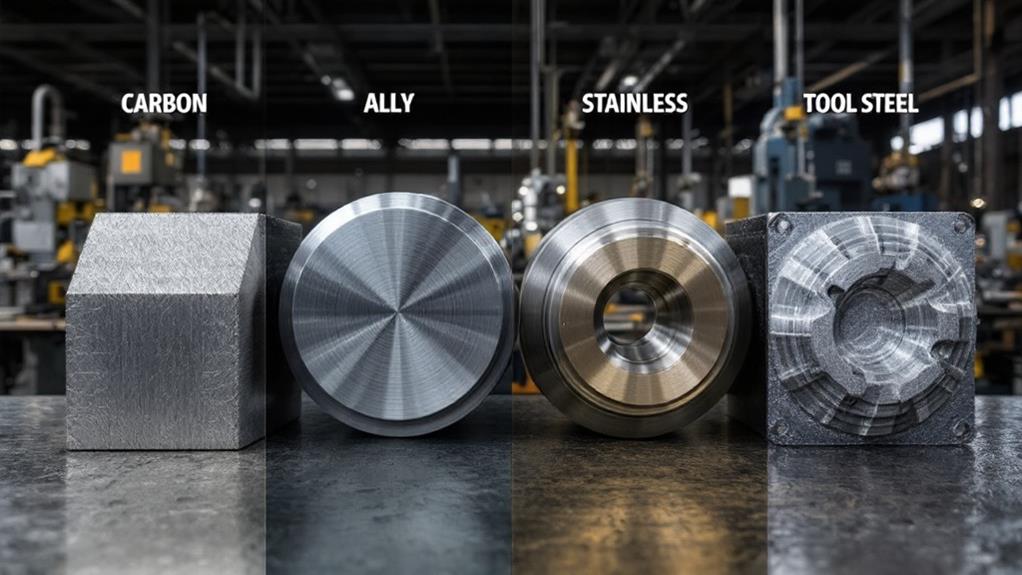What Are the Four Main Types of Steel? A Guide to Steel Categories and Uses

The four main types of steel are carbon steel, alloy steel, stainless steel, and tool steel. Carbon steel, accounting for 90% of production, offers versatility and strength. Alloy steel contains additional elements for enhanced performance in specific applications. Stainless steel provides corrosion resistance, making it ideal for harsh environments. Tool steel excels in hardness and wear resistance for precision tools. Each type has unique properties and uses, from construction to aerospace. You'll need to examine factors like weldability, machinability, and heat treatment when selecting the right steel for your project. Understanding these categories will help you make informed decisions in your manufacturing or engineering undertakings.
Carbon Steel: Properties and Applications
Carbon steel is the most widely used type of steel, accounting for about 90% of all steel production. It's primarily composed of iron and carbon, with the carbon content ranging from 0.05% to 2.1%. The higher the carbon content, the stronger and more rigid the steel becomes, but it also becomes less ductile.
You'll find carbon steel categorized into three main types: low carbon (mild steel), medium carbon, and high carbon steel. Each type has distinct properties and applications. Low carbon steel is highly formable and weldable, making it ideal for construction and automotive body panels. Medium carbon steel offers a good balance of strength and ductility, suitable for machine parts and railway tracks.
High carbon steel, with its high carbon content, is the most robust and unyielding of the three. It's often used in tools, cutting implements, and springs. However, it's less weldable and more brittle than its lower carbon counterparts. To enhance its properties further, high carbon steel often undergoes a heat treatment process, which can drastically improve its hardness and wear resistance.
Alloy Steel: Strength and Durability
Delving into the world of alloy steel reveals a class of materials engineered for enhanced performance. You'll find that alloy steel contains specific elements beyond carbon, such as chromium, nickel, or molybdenum, which greatly improve its properties. These alloying components work together to create a steel that's stronger, more durable, and resistant to various environmental factors.
When you're looking for steel that can withstand extreme conditions, alloy steel is often the go-to choice. Its increased strength-to-weight ratio makes it ideal for applications in aerospace, automotive, and construction industries. You'll appreciate how alloy steel responds to heat treatment effects, allowing for precise control over its mechanical properties. This means you can tailor the steel's characteristics to suit specific needs, whether it's high tensile strength, improved ductility, or enhanced wear resistance.
You'll find alloy steel in critical components like engine parts, industrial machinery, and high-performance tools. Its versatility and superior performance make it a crucial material in modern engineering, offering solutions to challenges where standard carbon steel falls short.
Stainless Steel: Corrosion Resistance

While alloy steel offers strength and durability, stainless steel stands out for its exceptional corrosion resistance. This unique property is due to the addition of at least 10.5% chromium, which forms a protective layer of chromium oxide on the surface. This invisible barrier shields the steel from oxidation and rust, making it ideal for applications in harsh environments.
You'll find stainless steel in various industries, from kitchen appliances to medical equipment. Its resistance to chemicals makes it perfect for use in chemical processing plants and laboratories. Additionally, its resistance to extreme temperatures allows it to perform well in both cryogenic conditions and high-heat applications.
There are several grades of stainless steel, each with specific properties customized to different uses. For example, austenitic stainless steels like 304 and 316 offer excellent corrosion resistance and are widely used in food processing and marine environments. Ferritic and martensitic grades provide enhanced strength and magnetic properties.
When choosing stainless steel for your project, consider factors such as the specific environment, required strength, and budget. With its combination of corrosion resistance, durability, and versatility, stainless steel continues to be a popular choice across numerous industries.
Tool Steel: Precision and Hardness
Tool steel represents a specialized category of high-carbon, alloy steel designed for exceptional hardness and wear resistance. You'll find this type of steel in various cutting, drilling, and shaping tools used in manufacturing and metalworking industries. Its unique composition, often including elements like tungsten, molybdenum, and vanadium, allows it to maintain its strength and sharpness even under extreme conditions.
To achieve its remarkable properties, tool steel undergoes specialized heat treatment processes. These treatments enhance its already high wear resistance and improve its ability to withstand repeated impacts and high temperatures. You'll encounter different grades of tool steel, each customized for specific applications. For instance, high-speed steel is ideal for cutting tools that operate at high temperatures, while cold-work tool steel excels in applications requiring dimensional stability.
When you're working with tool steel, you'll appreciate its precision and durability. It's the go-to material for creating dies, molds, and cutting tools that demand both accuracy and longevity. While it's more expensive than other steel types, its superior performance in demanding applications often justifies the cost.
Steel Production Process Overview

The trek from raw materials to finished steel is a complex and fascinating process. It begins with the extraction of iron ore, coal, and limestone from the earth. These raw materials are then transported to steel mills for processing.
The first major step is the blast furnace process, where iron ore is melted and reduced to create pig iron. This molten iron is then transferred to a basic oxygen furnace, where it's combined with recycled steel scrap and oxygen is blown through the mixture. This process removes impurities and reduces the carbon content, transforming the iron into steel.
Next, the molten steel is cast into various shapes, such as slabs, blooms, or billets. These semi-finished products are then further processed through rolling, shaping, and heat treatment to achieve the desired properties and forms.
Throughout the production process, various alloying elements may be added to enhance specific characteristics of the steel. Quality control measures are implemented at each stage to guarantee the final product meets the required specifications. The result is a versatile material that's essential for countless applications in modern society.
Comparing Steel Types Side-by-Side
Steel comes in numerous varieties, each with unique properties customized for specific applications. When comparing the four main types of steel side-by-side, you'll notice distinct differences in their material composition and manufacturing methods.
Carbon steel, the most common type, contains varying amounts of carbon, which affects its strength and hardness. Low carbon steel is ductile and easy to form, while high carbon steel is harder but more brittle. Alloy steel incorporates additional elements like manganese, nickel, or chromium to enhance specific properties. This type offers improved strength, toughness, and corrosion resistance.
Stainless steel stands out for its high chromium content, making it highly resistant to rust and corrosion. It's ideal for applications requiring hygiene or exposure to harsh environments. Tool steel, designed for cutting and shaping other materials, contains high amounts of carbide-forming elements like tungsten or molybdenum. This results in exceptional hardness and wear resistance.
Choosing the Right Steel Type

Selecting the ideal steel type for your project requires careful consideration of various factors. You'll need to assess the specific requirements of your application, including strength, durability, corrosion resistance, and formability. Consider the environmental conditions the steel will be exposed to, such as temperature extremes or chemical exposure.
Evaluate manufacturing considerations like weldability, machinability, and heat treatment capabilities. These factors can significantly impact your production process and overall costs. Don't forget to weigh the cost-effective options available, as some steel types may offer similar properties at a lower price point.
Consult with metallurgists or steel suppliers to get expert advice on the best steel type for your needs. They can provide beneficial knowledge into the pros and cons of different steel categories and help you make an informed decision. Remember that sometimes a combination of steel types might be necessary to achieve optimal performance.
Ultimately, choosing the right steel type involves balancing performance requirements with budget constraints. By thoroughly analyzing your project's needs and exploring various options, you'll be better equipped to select the steel type that best suits your application.
Future Trends in Steel Technology
As we look ahead, exciting developments in steel technology are on the horizon. You'll see emerging steel processing methods that promise to revolutionize the industry. These innovations will focus on improving strength, durability, and versatility while reducing production costs and environmental impact.
Sustainable steel manufacturing practices are becoming increasingly important. You can expect to see more eco-friendly production methods, such as hydrogen-based steelmaking and carbon capture technologies. These advancements will help reduce the industry's carbon footprint and meet growing environmental regulations.
Another trend you'll notice is the development of ultra-high-strength steels for lightweight applications in automotive and aerospace industries. These new alloys will offer improved fuel efficiency and performance without compromising safety.
Additive manufacturing, or 3D printing, is set to alter steel production. You'll witness the creation of complex steel structures with minimal waste and reduced energy consumption. This technology will enable rapid prototyping and customization of steel components.
Lastly, you can anticipate advancements in smart steel products, incorporating sensors and self-healing properties. These innovations will enhance the longevity and safety of steel structures in various applications.



